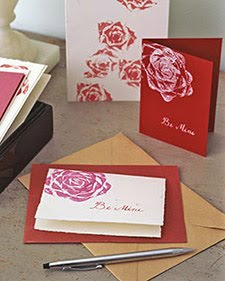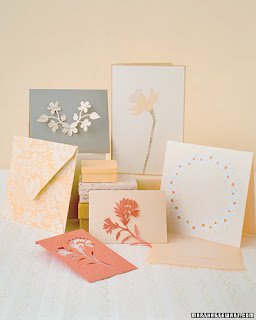Quilling, or paper filigree, is the art of creating intricate shapes from strips of paper. The technique is simple: After a long, narrow ribbon of paper is rolled around a needlelike tool, the strip is slipped off, arranged with your fingertips into the desired shape, and then glued to a background of contrasting paper, fabric, or wood.
Quilled motifs such as flowers and hearts express sweet sentiments for Valentine's Day and Mother's Day, but they also add an elegant touch to cards for any occasion.
In this tutorial, we'll show you how to make the shapes necessary to create several types of quilled cards.
Step 1
•5/8-inch multicolor quilling paper (No. 356), $
5 for 100 pieces, from Lake City Crafts, quilling.com
•1/8-inch quilling paper in color of choice, $1.45 for 50 pieces, from Lake City Crafts, quilling.com (You can also use medium-weight paper, such as vellum or stationery)
•8 1/2-inch paper trimmer, $24.99, from Martha Stewart Crafts available at Michaels (You will need this if you are making your own quilling strips.)
•Round-headed pin
•Slotted quilling tool (No. 171), $3.75, from Lake City Crafts, quilling.com
•Fine-pointed tweezers (No. 177), $3.75, from Lake City Crafts, quilling.com
•Small sharp scissors, by Martha Stewart Crafts, available at Michaels stores
Martha Stewart Crafts tools and supplies are available at Michaels, Walmart, AC Moore, Meijer, and independent craft stores.
Gather Materials
Don't let the elaborate effects fool you; quilling is simple. You need only a few basic crafts items.
Clockwise from top:
A round-headed pin is useful for precise glue application.
A slotted quilling tool lets you create coiled shapes with ease.
Fine-pointed tweezers are essential for tiny shapes.
Use small sharp scissors to cut fringe.
Quilling paper comes in a variety of colors and widths; most of our projects can be made with standard precut strips. If you prefer, use a paper cutter and medium-weight paper, such as vellum or stationery, to make your own; construction paper is too heavy and will not roll easily.
Step 2: Basic Quilling Shapes
Experiment with basic techniques before starting a project.
Loose Circle
Create a tight circle, but do not glue. Instead, lay it on a flat surface, and let it expand. When satisfied with the shape and size, glue the end of the strip to secure.
Loose Scroll
Form a loose circle, but do not glue closed.
Marquise
Fashion and glue a loose circle; pinch each end.
Connected Scrolls
Make several loose scrolls; position with unrolled ends pointing the same way. Curve each over rolled end of next scroll; glue.
Open Heart
Fold a strip in half, and crease. Roll each end toward center.
V Scroll
Crease paper at center; roll ends outward.
S Scroll
Form an S shape by rolling one end toward center, and the other in the opposite direction.
C Scroll
Roll both ends of a strip toward the center
Step 3 : Open Hearts
Open heart shapes are used in the quilled heart valentine. To make open hearts, fold a strip in half, and crease. Roll each end toward center and glue to card.
Step 4 : Tight Circle
Tight circles are one of the most basic quilled shapes, and are used to make the quilled frame cards.
To make a tight circle, slip paper into the slot on the quilling tool, placing paper's end flush with edge of slot.
Step 5 :Complete the Tight Circle
To complete the tight circle, turn tool until strip is rolled into a firm cylinder. Remove paper from tool, and glue closed to complete your tight circle.
Step 6 : Teardrop
Another common shape is the teardrop, which is also used in the quilled frame cards. To make a teardrop, create and glue a loose circle; pinch one end to form a point.
If you want to design a frame or border for your card, create a freehand pattern that incorporates several of the basic shapes you've learned. Alternatively, you can purchase a published pattern, many of which are available in clip-art books.
Here, we arranged a series of fleurs-de-lis, each made from three V scrolls of graduated sizes, and one teardrop. Form and glue individual shapes, using the pattern as a guide. Then use a ruler to draw a rectangle on the card. Dab points of glue on undersides of quilled shapes and position them, standing on edge, along the pencil line. Hold in place for 15 seconds to allow glue to set.
Step 8 : Fringed Flower
Fringed flower shapes are used in the quilled floral cards. To make a fringed flower such as a daisy or a zinnia, scallop the top of a strip of paper, and then cut fringe. (To create flowers with centers, glue together two strips of paper, each a different width and color, end to end; then fringe.) Roll entire length of paper into a tight circle, as shown here.
Step 9 : Complete the Fringed Flower
Glue closed. With your fingers, spread the fringe and separate it into petals. Curl the petal ends outward and downward with tweezers to achieve desired shape.
Step 10 : Bells
Bells are used to make the quilled lily-of-the-valley card. Roll and glue a tight circle. Using your finger, push center of circle to create a cone. Secure the end with glue. If desired, spread a light layer of glue over surface of bell; this will help the bell keep its shape. Or spread glue inside to hide the glued area. Positioned along four leafy stems made from strips of green paper to complete the lily-of-the-valley.
Step 11 :Script
Quilled script is used to make the scripted valentines. You can write a message in your own hand, adapt one from a calligraphy book, or create one on a computer. Lay short strips of quilling paper along the curves of each letter you want to form. Shape ends with quilling tool, or use scissors to curl paper as you would a ribbon; cut strips to correct length. Trace message onto paper. Glue at intervals, one letter at a time. Turn quilling paper on edge; use tweezers to hold it in place for 15 seconds to allow glue to set.
Classic valentine messages never go out of style. You can shape individual strips of paper, curling the ends as you would a ribbon, to form letters that resemble calligraphy. Use carefully placed dabs of craft glue to hold each letter in place on a card.
Quilled Florals
To make these elaborate quilled floral cards, create a trio of fringed flowers, such as daisies or zinnias, and glue them to folded card stock. Use an opaque pen to add a message in your own script.
For a lily-of-the-valley card, roll eight off-white bells, and position them along four leafy stems made from strips of green paper
You can write a message in your own hand, adapt one from a calligraphy book, or create one on a computer. Lay short strips of quilling paper along the curves of each letter you want to form. Shape ends with quilling tool, or use scissors to curl paper as you would a ribbon; cut strips to correct length. Trace message onto paper. Glue at intervals, one letter at a time. Turn quilling paper on edge; use tweezers to hold it in place for 15 seconds to allow glue to set.
http://www.marthastewart.com/article/quilled-floral-cards

















































